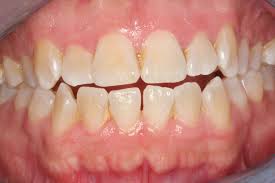Periodontal Disease
 |
Better known as gum disease in an infection of the gum and bone that hold teeth in place. If un treated, they can eventually lead to tooth loss. Periodontal diseases are often painless and you may not be aware that you have a problem until your gums and the supporting bone are seriously damaged. The good news is that periodontal diseases often can be treated in the early stages with a treatment called Scaling and Root Planning
|
What Causes Periodontal Disease?
Plaque is a mostly invisible film of bacteria that clings to teeth and gums. The bacteria in plaque cause irritation to the tissues that support your teeth. This irritation can lead to chronic inflammation and infection that can destroy your gum and bone tissue.
Plaque that is not completely removed may harden(calcify) into a rough, porous deposit called tarter, or calculus. Tartar by itself does not seem to cause disease, but it typically makes it more difficult to remove plaque that it can thrive on, in or near the tartar. The only way to limit the disease-causing effects of tartar is to have your teeth cleaned regularly at the dentist office.
Diagnosing Periodontal Disease
Dr. Kantarovich can detect developing periodontal disease before the gums and the bone are supporting the teeth are irreversibly damaged. Periodontal diseases are progressive, left untreated, the condition will often become worse.
During a check up, Dr. Kantarovich will examine your gums for periodontal problems. An Instrument called a periodontal probe is used to gently measure the depth of the spaces between your teeth and gums.
At the very edge of the gum line, healthy tissue forms a very shallow, v-shaped grove between the tooth and gums. The normal depth of the sulcus should be three millimeter or less. With periodontal diseases this normally shallow sulcus develops into a deeper pocket that collects more plaque and bacteria and is difficult to keep clean.
Gingivitis is the initial stage of periodontal disease. Affected gum areas become increasingly red or dark. They may appear swollen and may bled easily. The condition is reversible at this stage. If not treated, gingivitis may lead to a more serious condition called periodontitis.
Periodontitis irreversibly damages the gums, bones and other structures that support the teeth. At this stage, the disease may require more complex treatment to prevent tooth loss. In the worst case, teeth can become loose and fall out- or they may need to be extracted.
Warning Signs of Periodontal Diseases
- Gums that bleed easily
- Red, swollen or tender gums
- Gums that have pulled away from the teeth
- Pus between the teeth and gums when the gums are pressed
- Permanent teeth that are loose, separating or changing position
- Persistent bad breath or bad taste
- Any change in the way your teeth fit together when you bite
- Any change in the fit of partial dentures
Prevention is the first line of defense. This includes a good daily oral hygiene routine at home and regular dental checkups are important in preventing periodontal disease.
Scaling and root planing is a method of treating periodontal disease when pockets are greater than 3mm.. Scaling is used to remove plaque and tarter beneath the gum line.. A local anesthetic will be given to reduce any discomfort. Using an instrument called a small scaler or an ultra sonic cleaner, plaque and tarter are carefully removed down to the bottom of each periodontal pocket. The tooth's root surfaces are smoothed or planed. this procedure allows the gum tissue to heal. The procedure makes it more difficult for plaque to accumulate aling the root surfaces.
Depending on the extent of the disease, Dr. Kantarovich may recommend that one or more session (quadrants) of the mouth be treated with scaling and root planning.
Periodontitis will not go away by itself. Left untreated, surgery may be needed to save affected teeth. A visit with Dr. Kantarovich will give you a proper assessment of your teeth and gums. He can then make the recommend the best treatment option for you. Preventing and treating the disease in the early stages are the best way to keep your smile healthy.


